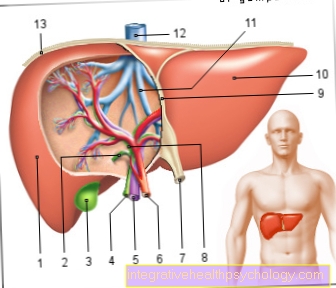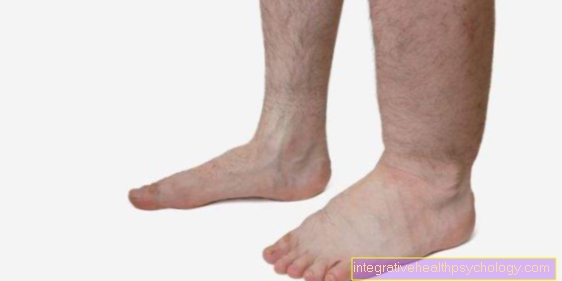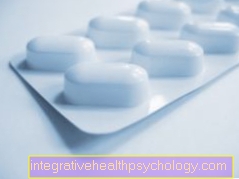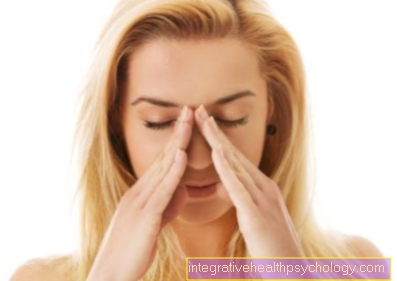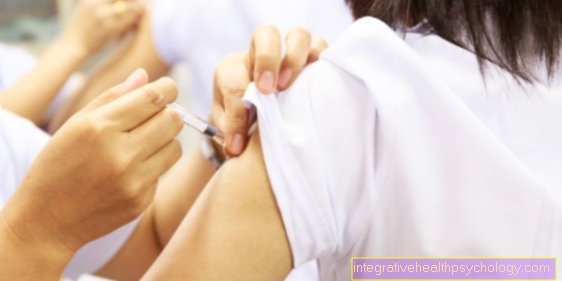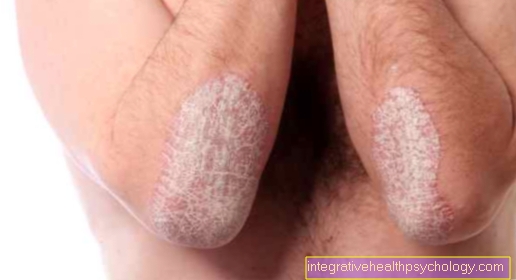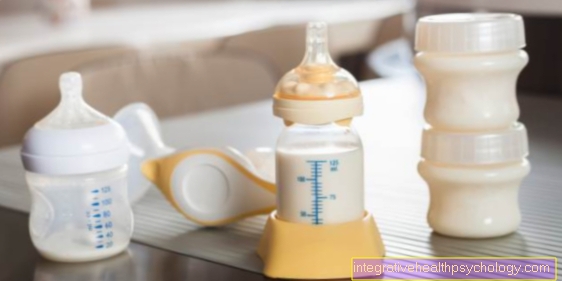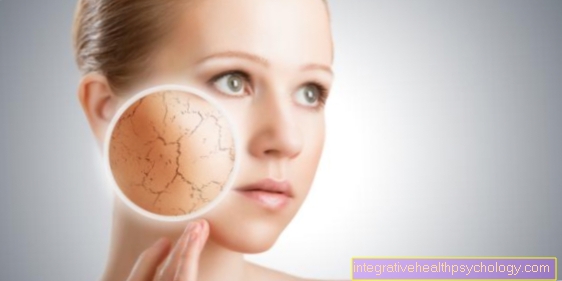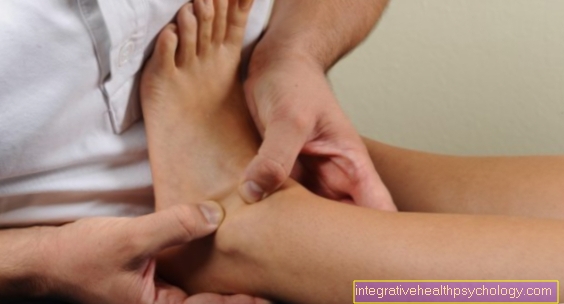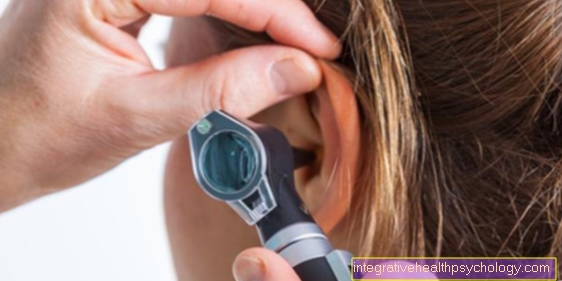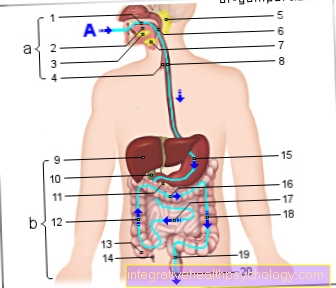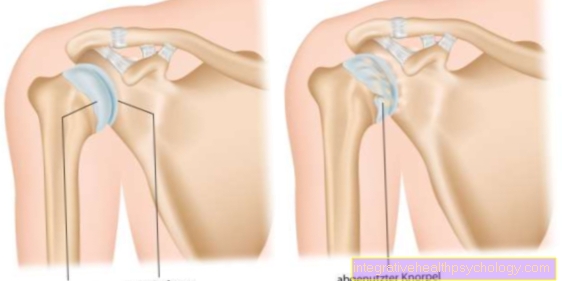pollen allergy
definition
A pollen allergy is the hypersensitive reaction to components of different plant pollen.
The pollen allergy is popularly known as "hay fever" and in technical terms it is called "allergic rhinitis".

In most cases, the disease begins in early childhood and usually accompanies those affected for life. A disease rate of between 15% and 30% in children and adolescents is assumed. That means that almost every fifth child suffers from a pollen allergy. The therapy consists of avoiding pollen, pharmacological allergy drugs and specific immunotherapy.
causes
The immediate cause of the symptoms of pollen allergy is the body's exaggerated immune response to the plant pollen.
These are harmless in themselves, so they do not normally pose a health risk to humans. In the case of an allergy, however, certain proteins in the plant pollen are (incorrectly) recognized as pathogens.
This activates the immune system. The activation of the immune system leads to an inflammatory reaction.
This occurs particularly in the areas that have had contact with the allergen, i.e. the pollen. The points of contact are mainly the mucous membranes of the airways and the eyes.
The messenger substances histamine and leukotriene play a particularly important role. The cause of the allergy has not yet been adequately clarified. The tendency to develop an allergy is inheritable.
It is also assumed that too strong hygiene in childhood is conducive to the development of an allergy. City children in particular, who are less exposed to nature, are more likely to develop a pollen allergy than rural children. In addition, air pollution increases the body's allergic reaction.
Concomitant symptoms
The classic symptoms of a pollen allergy are runny nose, watery eyes and sneezing fits.
Severe itching is also one of the leading symptoms of hay fever.
In principle, the symptoms are explained by the pathomechanism (mode of action of the disease) of the allergy. The fact that more messenger substances such as histamine, leukotrienes and prostaglandins are released from the mast cells lead to inflammatory reactions. These are mainly located in the body regions that had contact with the pollen. One result of the inflammatory reaction is a widening of the blood vessels. This causes the region to be supplied with more blood and to appear reddish.
In addition, the permeability (permeability) of the blood vessels also increases. This leads to an increased leakage of liquid from the vessels. This accumulation of fluid manifests itself as swelling of the mucous membranes in the patient.
The prostaglandins also increase the sensation of pain and itch. The symptoms are mainly redness, swelling, increased pain perception and itching.
The itching often affects the patient's throat and roof of the mouth and can reach the ear. This manifests itself in the nose as a so-called runny nose. This form of runny nose is characterized by a strong discharge of secretion.
In addition, the swollen lining of the nose blocks the airway in the nose and makes it harder to breathe through the nose.
In most cases, there are also severe sneezing attacks, which can sometimes last for minutes. The bronchi and windpipe can also be affected by the allergy. This sometimes leads to coughing, in severe cases even to shortness of breath.
If there is a whistling noise when breathing at night, it is probably bronchial asthma. In many cases this is also due to the allergy. As with other diseases, energy is withdrawn from the body through the allergic inflammatory reaction. As a result, many of those affected feel tired and exhausted.
Sleep can be impaired by the pollen allergy, which increases tiredness during the day and severely restricts the sick person in their everyday life.
Symptoms around the eyes
In addition to the airways, the eyes can also be affected by the allergic reaction. Here, for example, swelling of the eyelids occurs.
This can mean that the eyes can no longer be opened that wide. In addition to swollen eyelids, circles under the eyes are a classic symptom of a pollen allergy. On the other hand, the eyes water a lot, while still often feeling dry eyes. A foreign body sensation, which can occur, fits this. A sensation that is like sand in the eye is often reported.
Visual problems in particular can be problematic. These rarely occur, but they represent a considerable impairment in everyday life. In addition, the eyes can react more sensitively to light. Because the conjunctiva of the eye is not protected by a mucous membrane (in contrast to the nose or the respiratory tract), irritation can often occur here.
Conjunctivitis can also occur in some cases. In contrast to infectious conjunctivitis, allergic conjunctivitis is not contagious because it is not triggered by bacteria.
For this reason, however, it can only be treated symptomatically; an antibiotic does not help here. The conjunctivitis is characterized on the one hand by itching and burning of the eyes. Redness and increased tearing are also part of the classic conjunctivitis disease.
itching
The itching is a symptom that occurs in many clinical pictures, especially in inflammatory or allergic diseases.
In the case of a pollen allergy, itching is also one of the characteristic symptoms. The itching is caused by messenger substances such as Histamine, triggered. The histamine is released to a greater extent as a result of the body's allergic defense reaction and acts mainly at the point where the body came into contact with the allergen.
In the case of pollen allergy, it is primarily the eyes and airways. But also in the skin there is a strong release of histamine in an allergic reaction.
How exactly the histamine triggers the itching is not yet certain, but it is possible to combat the itching with the help of antihistamines (histamine receptor blockers).
Red spots on the skin
Red spots on the skin are also known in technical terms as rashes or rashes. These rashes can occur with a pollen allergy and are often located in places that have had contact with the pollen. Most of the time, the arms, legs and head are affected by the rashes. These express themselves as redness, sometimes wheals or blisters can also be found. In addition, the skin feels warm.
The pollen can penetrate the skin via hair follicles or lesions and trigger the allergic reaction there.
A systematic effect can also occur. The body releases so much histamine that it is systematically distributed through the blood and can cause problems in other parts of the body.
For example, the intestines or the skin are affected. In the event of an allergic rash, the skin can be treated with antihistamines. In severe cases, the administration of glucocorticoids (cortisone) is also conceivable.
Read more on this topic at: Rash from pollen
diagnosis
In many cases an allergy can be diagnosed with a good medical history (discussion of the medical history). Especially if the symptoms occur more frequently at a certain time of the year or only in the open air.
In addition, certain provocations of the body with the help of potential allergens can diagnose an allergy. For example, you can prick proteins from different plants into the skin with a fine needle and wait to see whether there is an allergic reddening at the puncture site (prick test).
Alternatively, a blood test can be done to check for antibodies against the pollen.
The last option is a direct provocation test, in which the potentially allergenic substance is applied to the mucous membrane. However, this should only be done under medical supervision.
Treatment of a pollen allergy
The therapy for pollen allergy consists of three components.
First of all, it is important to avoid contact with the allergens. This is difficult with a pollen allergy, because despite the pollen allergy you would still like to step outside the front door. One possibility is to change clothes after entering the apartment and possibly even to wash your hair.
In addition, the pollen load is no longer so strong after a rain shower. So if possible you should leave the house after a rain. You can also use respiratory masks. These are also used during construction work to protect themselves from dust. They keep the pollen away from the respiratory tract and help to exercise even when there is a lot of pollen.
The second component of therapy is drug therapy. Medicines such as antihistamines (histamine receptor blockers), glucocorticoids (cortisone) or sympatomimetics (nasal spray) are used. These help to swell the mucous membranes and contain the symptoms of inflammation.
The third component of therapy is specific immunotherapy. This is also known as "desensitization" or "desensitization".
desensitization
Desensitization is nowadays replaced by the terms “specific immunotherapy” or “desensitization”.
It describes the only therapy that combats the cause and not just the symptoms of the allergy.
Immunotherapy should be started as early as possible; it is usually possible from the age of five. The reason to start early is that people with allergies to one or a few substances have a higher chance of success than people with many allergies.
During treatment, the patient is exposed to increasing doses of allergoids. Allergoids are allergens that have been purified and standardized. So they have been modified for medical use.
One tries to achieve that the sensitivity of the body to the allergens decreases over time.
The body gets used to the allergens, so to speak. Therefore, the excessive reaction of the immune system does not occur.
The duration of therapy is usually around 3 to 5 years. In pollen allergy sufferers, desensitization is often interrupted during the pollen season and continued after the pollen season.
Medication for a pollen allergy
There are effective drugs against pollen allergy. However, these only fight the symptoms, not the cause of the allergy.
For example, antihistamines are popular.
The newer generation of antihistamines has few side effects compared to previous generations and can be used as a nasal spray (locally) or in tablet form (systemically via the blood).
Glucocorticoids (cortisone) can also be applied locally or systemically. Glucocorticoids are ascribed the strongest effect in drug therapy for allergy symptoms, although systemic glucocorticoid therapy can have severe side effects when used for a long time.
Sympathomimetic drugs (substances that are similar to adrenaline) in the form of nasal sprays or nasal drops also help to swell the nasal mucous membrane.
But even they should only be used for a short period of time, as it can quickly lead to dependence or inflammation of the nasal mucosa (rhinitis medicamentosa).
Duration of a pollen allergy
The duration of the allergy is unlimited. Many people affected suffer from a pollen allergy for life.
However, since different pollen is only present in the air at certain months of the year, the duration of the symptoms varies greatly. The pollen count generally lasts from January to September.
However, the pollen of the individual plants is only present in the air for about two months a year.
A pollen calendar can be helpful here, which shows the exact periods of pollen flight of the specific plants.
Cross allergies
A cross allergy is a reaction in which the body's antibodies (immunoglobulin E) recognize other substances as well as the substances that actually trigger the allergy.
To better explain this one should give an example. In the case of pollen allergy, the person's body is allergic to the proteins of the pollen from a certain plant (e.g. birch). The antibodies against these proteins recognize the pollen as a foreign body.
If a substance (e.g. food) appears that has a similarity to the pollen protein to which the allergic reaction occurs, a new allergy to this food (e.g. nuts) can occur.
So you develop further allergies to other substances through the pollen allergy. In this case, an allergy to birch pollen would result in an allergy to nuts. In addition to food, it can also be other plant pollen.
For this reason, early therapy with the help of desensitization or desensitization is essential.
Read more about this at: Cross allergy



